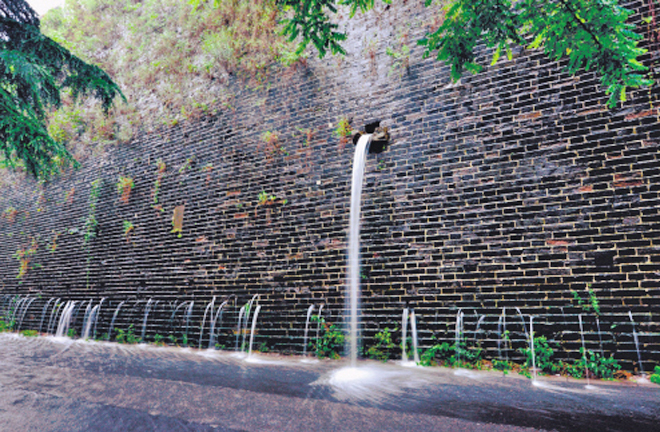Scholars: Cities need ‘resilience’

Rainwater is drained away through the city walls built in Ming Dynasty in Nanjing after a rainstorm, which gives rise to the phenomenon known colloquially as the dragons spitting water.
The flooding in several cities in China after summer rainstorms has shown the public how weak modern cities can be in the face of the Mother Nature, which is why the phrase “resilient city research” has become a buzzword in urban planning in recent years.
“In ecology, resilience refers to the ability of an ecosystem to regain a stable state after a disturbance,” said Huang Xiaojun, an associate professor from the College of Urban and Environmental Science at Northwest University in Shaanxi Province. Later, this concept was expanded to areas such as socioeconomic and urban-planning systems, he added.
The concept of a resilient city emphasizes a city’s ability to maintain its basic structure and function by absorbing and adapting to challenges posed by risks and uncertainties, Huang said. Traditional urban planning focused more on reducing the potential for disturbances, whereas resilient urban planning addresses changes head-on to develop new strategies and innovative systems. In this sense, a resilient city is one that knows how to learn, recover and create, Huang said.
The resilient urban system describes the city as a sustainable network based on physical factors such as roads and buildings, and social factors in the human community, such as schools and enterprises, said Gu Chaolin, a professor from the School of Architecture at Tsinghua University. Therefore, many scholars have emphasized the combination of technological and social measures in reducing the impact of natural disasters on resilient cities, he added.
Huang said that China’s practice of “sponge cities” in urban planning is a special form of resilient urban planning. Sponge cities were designed to absorb and release rainwater like a sponge, in order to avoid floods, waterlogging, and droughts.
Unlike most foreign cities, China’s sprawling metropolises are home to large populations and are engaged in a constant process of industrialization and urbanization, which complicates the efforts at urban planning, Huang said. Therefore, China’s urban planning should be considered a long-term process, and constant evaluation, adjustment and innovation of the master strategy should be made.
Huang also suggested that resilient urban planning should focus on the weakest parts—physical and social—of the urban system. Urban planning should strengthen the capacity of different groups of people to adjust to shocks brought by natural uncertainties, he said.
Zhang Qingli is a reporter at the Chinese Social Sciences Today.

 PRINT
PRINT CLOSE
CLOSE